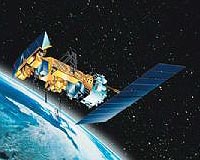| . |  |
. |
Berkeley CA (SPX) May 21, 2009 Global warming may include some periods of local cooling, according to a new study by researchers at the University of California, Berkeley. Results from satellite and ground-based sensor data show that sweltering summers can, paradoxically, lead to the temporary formation of a cooling haze in the southeastern United States. The study, to be published in the journal Proceedings of the National Academy of Sciences, found that when manmade pollutants mix with the natural compounds emitted from forests and vegetation during the hot summer months, they form secondary aerosols that reflect light from the sun. Such aerosols may also contribute to the formation of clouds, which also reflect sunlight. The results of this study suggest that climate models need to better account for the effects of organic aerosols, the authors said. The researchers conducted observations of aerosols throughout the earth's atmosphere using space-based satellites in combination with ground-based sunphotometers between March 2000 and February 2007. "This is the first time a study has shown that the aerosols formed from the combination of manmade and natural emissions observed from space are relevant for understanding earth's climate," said study lead author Allen Goldstein, UC Berkeley professor and chair of the Department of Environmental Science, Policy and Management. The study began when former UC Berkeley Ph.D. student and study co-author Charles Koven showed Goldstein satellite data that indicated a summertime spike in aerosol haze in the southeastern United States. Goldstein noticed that the increased haziness, which could not be explained by human activities alone, coincided with the known regional pattern of biogenic volatile organic compounds. The emission of these compounds - natural hydrocarbons from plants and trees - increases exponentially when the temperature rises, said Goldstein. "These natural emissions are highly volatile, and when they react with human sources of pollution in the atmosphere, aerosols are created," said Goldstein, who also holds a joint faculty appointment in the Department of Civil and Environmental Engineering. "Nobody realized until now that enough of these aerosols were forming to influence cooling over an entire region." The researchers estimated that the cooling effect from the aerosol haze over this region in summer is outpacing the warming effect from carbon dioxide emissions by 2-to-1 in a negative feedback system. The results do not mean, however, that aerosols negate the effects of carbon dioxide emissions, emphasized atmospheric scientist Inez Fung, co-director of the Berkeley Institute of the Environment and a co-author of the study. "The cooling effect of the organic aerosols we are reporting here are regional and temporal; they are dwarfed by the changes in the climate we are witnessing globally," said Fung, a UC Berkeley professor with joint appointments in the Department of Earth and Planetary Science and the Department of Environmental Science, Policy and Management. "Aerosols only remain in the atmosphere for five to 10 days, whereas carbon dioxide lingers for decades. To counter all the warming effects from greenhouse gases with aerosols, levels would have to be so high that we'd have trouble breathing, and the sky would no longer appear blue." Share This Article With Planet Earth
Related Links University of California - Berkeley Weather News at TerraDaily.com
 Fengyun-2E Weather Satellite Begins Weather Monitoring
Fengyun-2E Weather Satellite Begins Weather MonitoringBeijing (XNA) May 20, 2009 China's Fengyun-2E weather satellite started its round-the-clock operations Tuesday, according to the China National Bureau of Science, Technology and Industry for National Defense. At the transfer ceremony of the satellite to the China Meteorological Administration, Sun Laiyan, vice director of the bureau, said that the satellite has passed all tests and demonstrated stable performance si ... read more |
|
| The content herein, unless otherwise known to be public domain, are Copyright 1995-2009 - SpaceDaily. AFP and UPI Wire Stories are copyright Agence France-Presse and United Press International. ESA Portal Reports are copyright European Space Agency. All NASA sourced material is public domain. Additional copyrights may apply in whole or part to other bona fide parties. Advertising does not imply endorsement,agreement or approval of any opinions, statements or information provided by SpaceDaily on any Web page published or hosted by SpaceDaily. Privacy Statement |